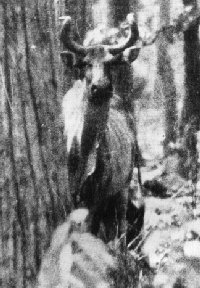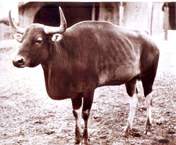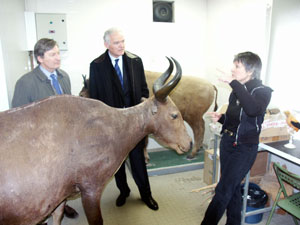Kouprey Debate
Posted by: Loren Coleman on September 17th, 2006

One of the first photographs taken in the wild of the elusive kouprey.
Kouprey (Bos sauveli), a wild forest-dwelling ox, was discovered in 1937. (Indeed, the kouprey is discussed as an animal of discovery in cryptozoology, on page 128, here.)
The 250 or so living kouprey are located in northern Cambodia and apparently also in western Vietnam, southern Laos, and eastern Thailand. The few kouprey found in Thailand, for example, were believed extinct for over two decades, and only rediscovered in the 1990s. In 1994, scientists began paying attention to lore about a possible second species of kouprey, a smaller version. More information needs to be gathered about them. Kouprey mysteries remain.

This photograph (above) was taken in 1937 of a kouprey at the Vincenes Zoo, Paris; the animal died in 1940.
But a recent report published by Northwestern University scientists (Gary J. Galbreath, the lead author and two others) in London’s The Journal of Zoology indicate that a comparison of mitochondrial sequences shows the kouprey to be little more than a hybrid between a zebu (Bos taurus indicus, formerly Bos indicus), the famed humped cattle of India, and a banteng (Bos javanicus), a wild ox of Southeast Asia and Indonesia.
There is a dispute, however.
This week the New York Times overviewed this debate, noting the:
…three biologists from Northwestern University and the Cambodian Forestry Administration have proposed a taxonomic demotion. In a paper published online in July by The Journal of Zoology, they say the kouprey is probably a domestic hybrid that became feral, a zoological poseur, not a valid species.
The biologists‚ proposal has met stiff opposition within the small group of scientists who study Asian wild cattle. Several say the paper misinterpreted the genetics and history of the kouprey, which may still exist in domesticated form. Although rare, elusive and enigmatic, kouprey are recognizable enough, longer-legged, more graceful, faster and slightly larger than the closely related banteng, and slightly smaller than the gaur, the largest of the wild cattle.
and later in the article:
[The] two French scientists, Alexandre Hassanin and Anne Ropiquet of the National Museum of Natural History in Paris…have fired back. In a recently submitted paper, they argue hypothetically that if the Cambodian banteng represents a separate species from the Javan banteng, then the kouprey could have derived from the Cambodian version, as the Galbreath team proposes. But it was more likely, Dr. Hassanin said in an e-mail message, that the kouprey was a natural species that evolved in Southeast Asia. On at least one occasion more than 100,000 years ago, a kouprey mated with a banteng. Their descendants are Cambodia‚s banteng, with mitochondrial DNA more closely resembling kouprey than banteng.
To complicate matters further, last February Dr. Hassanin and other colleagues published a paper in the journal Comptes Rendus Biologies arguing that a specimen mounted in 1871 in Paris and thought to be a domestic ox from Indochina was, in fact, a domesticated kouprey. The specimen has been at the museum in Bourges since 1931.
Dr. Hassanin said several indigenous Asian breeds of cattle might be derived from kouprey. Herds, especially in Cambodia, should be tested to see whether any are pure kouprey, Dr. Hassanin and his colleagues said, adding that if they are, steps should be taken to preserve them.
Where Dr. Hassanin sees pure kouprey, Dr. Galbreath finds his banteng-zebu hybrid. Independently, both say that more extensive sampling and analysis of mainland banteng are needed to determine who is correct. Commenting on the papers, Simon Hedges, an Asian cattle specialist with the Wildlife Conservation Society who was not involved in either study, tended to agree that the Cambodian banteng had probably hybridized with the kouprey. But he also suggested that the kouprey both groups studied might itself have been a banteng-kouprey cross.

The above pictured kouprey is the misidentified animal that arrived at the menagerie of the botanical garden of Paris in 1871. After its death, it was mounted and placed in the Natural History Museum of Paris, before being entrusted in 1931 to that of Bourges. Its heading: “Ox of Kampuchea, gift of the Minister for the Navy.” (Kampuchea is another name, used by some, for Cambodia.)
Only in October 2003, did questions arise about this ox. Indeed, at the time of the Conference of Mammalogy organized in Bourges, the person in charge for the collections of the National History Museum was intrigued by this ox resembling no specimen which he knew. Following this opinion, the natural history museum decided to investigate the identity of this animal. An analysis DNA made it possible to identify this ox: it is a kouprey of male sex. The purity of the animal has raised several questions about later DNA analysis, such as done by the Northwestern University team. The debate about the kouprey is anything but cold.

There apparently is a kouprey in this photo. Can you see it? This gives you an idea of how elusive the kouprey was until technically discovered by Western Science in 1937 – and still is. Now the debate as to the status of the kouprey serves to add another level to the enigma of the animal.
About Loren Coleman
Loren Coleman is one of the world’s leading cryptozoologists, some say “the” leading living cryptozoologist. Certainly, he is acknowledged as the current living American researcher and writer who has most popularized cryptozoology in the late 20th and early 21st centuries.
Starting his fieldwork and investigations in 1960, after traveling and trekking extensively in pursuit of cryptozoological mysteries, Coleman began writing to share his experiences in 1969. An honorary member of Ivan T. Sanderson’s Society for the Investigation of the Unexplained in the 1970s, Coleman has been bestowed with similar honorary memberships of the North Idaho College Cryptozoology Club in 1983, and in subsequent years, that of the British Columbia Scientific Cryptozoology Club, CryptoSafari International, and other international organizations. He was also a Life Member and Benefactor of the International Society of Cryptozoology (now-defunct).
Loren Coleman’s daily blog, as a member of the Cryptomundo Team, served as an ongoing avenue of communication for the ever-growing body of cryptozoo news from 2005 through 2013. He returned as an infrequent contributor beginning Halloween week of 2015.
Coleman is the founder in 2003, and current director of the International Cryptozoology Museum in Portland, Maine.










Once again taxanomic inflation meets cryptozoology! What does really constitute a species? Inteesting to read that domesticated hybrids seem to be almost immediatly dissmissed and, in this case not even given breed or race status simply a hybrid. Again this bolsters the argument for some sort of universially accepted measures of divergence to difine taxa/sub taxa and the like.
Cool “spot the bull” pics too!
I’ve read that hybrids are common, or at least were: desiring kouprey traits, farmers would stake their cows (bantengs?) out in the forest to be found by kouprey bulls. My bet is that the kouprey is a valid species, but, with the “pure” wild population very small and still dwindling, hybrid forms may soon be the only kouprey in existence.
Lower right, taking it easy? Looking directly at the camera through the grass.
I do not believe that DNA examination is completely reliable for the identification of separate species in the case of such genetically plastic animal families as the Bovidae and the Canidae. Different members of both groups have been domesticated in various places since prehistoric times. People being the nomadic creatures that we are, and attracted to novelty the way we are, every where people have ever traveled we have interbred our domestic stock with the indigenous animals. Since most inter-species hybrids in the Bovidae (and Canidae) are fertile, even in the first generation, after a few generations have passed, it becomes nearly impossible to determine what genes originally came from which species. Many species which existed in small numbers or isolated locations have undoubtedly been assimilated into the large and varied gene pools of domestic stock around the world. I believe several species no longer exist as distinct species because of this assimilation.
For instance, I do not believe that the gray wolf as we know it today is the only progenitor of the domestic dog. There are just too many forms and patterns and colorations within the species DOG, that simply do not exist in the species GRAY WOLF.
Same thing with cattle. I do not believe that Bos aurochs and Bos indicus are the only ancestors of Bos taurus. The primary ancestors, yes. The only ancestors, no.
I believe that kouprey are a distinct species which is closely related to the species (I read that as “species”, plural) from which zebu were derived. It is very likely that more than one subspecies or even more than one distinct species of kouprey (and other wild cattle) exist or have existed within recent times.
Whether they will continue to exist, given the widespread deforestaion and fragmentation of the fragile ecosystems in which they evolved, is problematic. The world is – tragically – running out of room for large wild animals as the human population explodes out of control.
The head on image of the animal in the top most photo does NOT represent the bovine looking animal in the 2nd photo.
Though interesting, the “cow” in the 2nd photo is not nearly as interesting as the truly extraordinary creature in the top photograph.
When was the top photo taken, and where specifically?
No doubt the numbers of this species are probably quite small.
I think it’s well past time that biologists had a conference and settled on a definition of just what IS a species, much as the Astronomical Union recently did concerning the definition of planet.
Very interesting debate. Maybe the sides could work together to come to a conclusion. Appears like a battle for the sides to get their journal articles published. Sounds like a research article critique is in order, as well as for the evidence. Interesting animal with quite the history.
Yeah, the one in the top picture looks like a cross between an Elk and one of those striped large African antelope. I forgot their name. Anyway it does not look like the second picture at all. Could it be the angle of the picture? I doubt it. The neck looks much longer in the first animal, and the horns look almost antler-like. I live in Colorado and see lot’s of elk and the horns look like the velvet stage in a young bull.
“The above pictured kouprey is the misidentified animal that arrived at the menagerie of the botanical garden of Paris in 1871.”
Funny picture. It looks like it came to stay and is participating in a conference about how to get rid of it.
Kittenz
The question is are they genotypically plastic or is it phenotypic plasticisity alone? I’m not to hot on all that bovine, but I do know, as a comparative example that the domestic dog (Canis familiaris) has shown massive phenotypic variability only a very short evolutionary history with very little genetic variance, (weather that is from a single source or was formed by various ancestral backcrosses I’m not sure but remember evolution is not linear). And despite such range of morphology they all my most accepted definitions a single species. Like cattle breeds many traits have been selected for artificially by man, but still it lays testimony to the potential rate of morphological evolution WITHOUT genetic divergence. Either way, we should still look at the Kouprey as a rare and invaluable animal whatever its phylogenetic history.
Still can’t see it in the pic mind!
Good point about genotype vs phenotype. Fertile inter-species crosses are well documented in both Canidae and Bovidae. It will probably never be known for certain which wild species other than the gray wolf (and to much less extent the dingo) contributed to the domestic dog’s gene pool.
The evidence for the possibility of assimilation of one species into another, larger gene pool is right before our eyes today, at least as far as Canidae are concerned: two examples that come to mind are the Red Wolf and the Ethiopian Wolf.
The Red Wolf was rapidly becoming assimilated into the coyote gene pool; debate continues as to how many (some would ask whether any) pure Red Wolves exist. Capture and captive breeding of a small group of animals believed to be purebred may save that species; it is simply too soon to tell. Red Wolves also figure (at least anecdotally) in the development of some domestic dog breeds: notably the Catahoula Leopard Dog and some of the other curs. Dingos, which I consider to be a distinct species closelty related to dogs and wolves, also hybridize readily with domestic dogs and are in danger of losing their identity in some areas.
The Ethiopian Wolf population crisis may be more relevant to this discussion: this wolf, which is in many ways very doglike, is hybridizing with domestic dogs, at least at the fringes of its range. Given the tiny remnant population of the wolves that exists, and the pressure on that population from canine diseases such as rabies and distemper, destruction of habitat and hybridization could conceivably eliminate the Ethiopian Wolf as a distinct species within a few decades.
Possibly human intervention will come in time to prevent this. But in earlier times, when most people did not have the enlightened view of predators that is prevalent today, situations similar to these may have occured without being recognized until it was too late for the remnant species.
Who knows how many such small, fragmented, remnant species have been overwhelmed by and assimilated into larger gene pools over the millenia?
People have probably kept pets for as long as we have been people. I believe that our universal propensity to take and keep pets is one of the traits that marks our species as human.
Even tribal people who do not keep domestic stock usually have pets taken from the local fauna: monkeys, parrots, civets, mongooses, the occasional jackal or fox puppy, etc.; the list is as almost varied as the fauna itself. Modern humans in a natural state are almost invariably nomadic to some extent. In all species the instinct to reproduce is very strong. Since the vast majority of pets in history and in prehistory have NOT been rendered incapable of reproducing, it surely was inevitable that nomadic people’s pets’ sometimes mated with related but different species within the local fauna. It will probably never be known just how much influence those random matings had in the evolution of our domestic animals.
But I will leave that for another discussion sometime.
I LOVE cryptomundo! I wish I’d found this long ago. The Maine mutant story drew me in. I sure do enjoy and appreciate these lively topics and discussions.
the first photo looks more like an elk with cow horns. The second looks like a domesticated cow. By the way, unless it is lying down in the grass to the bottom right, there isn’t one in the last photo.